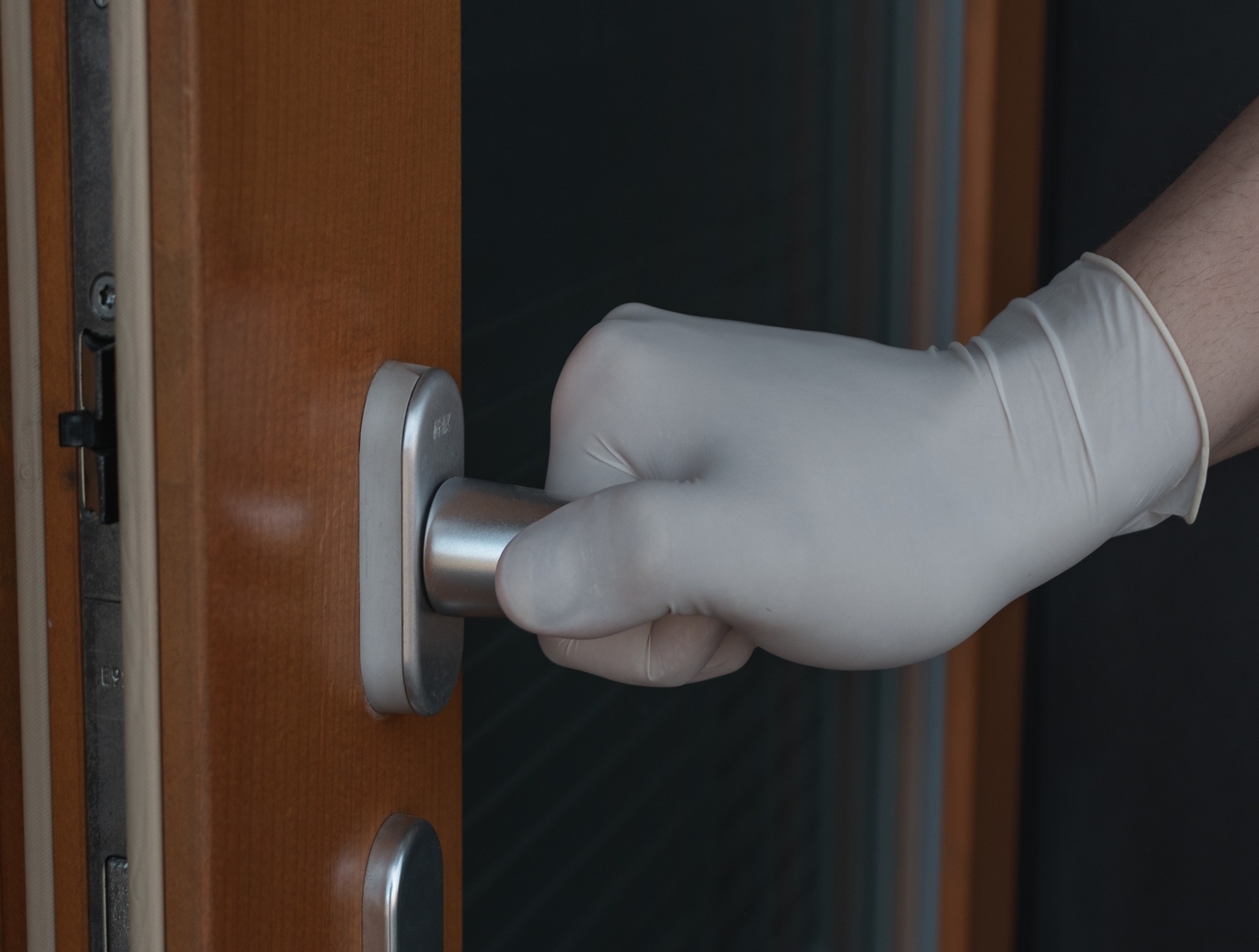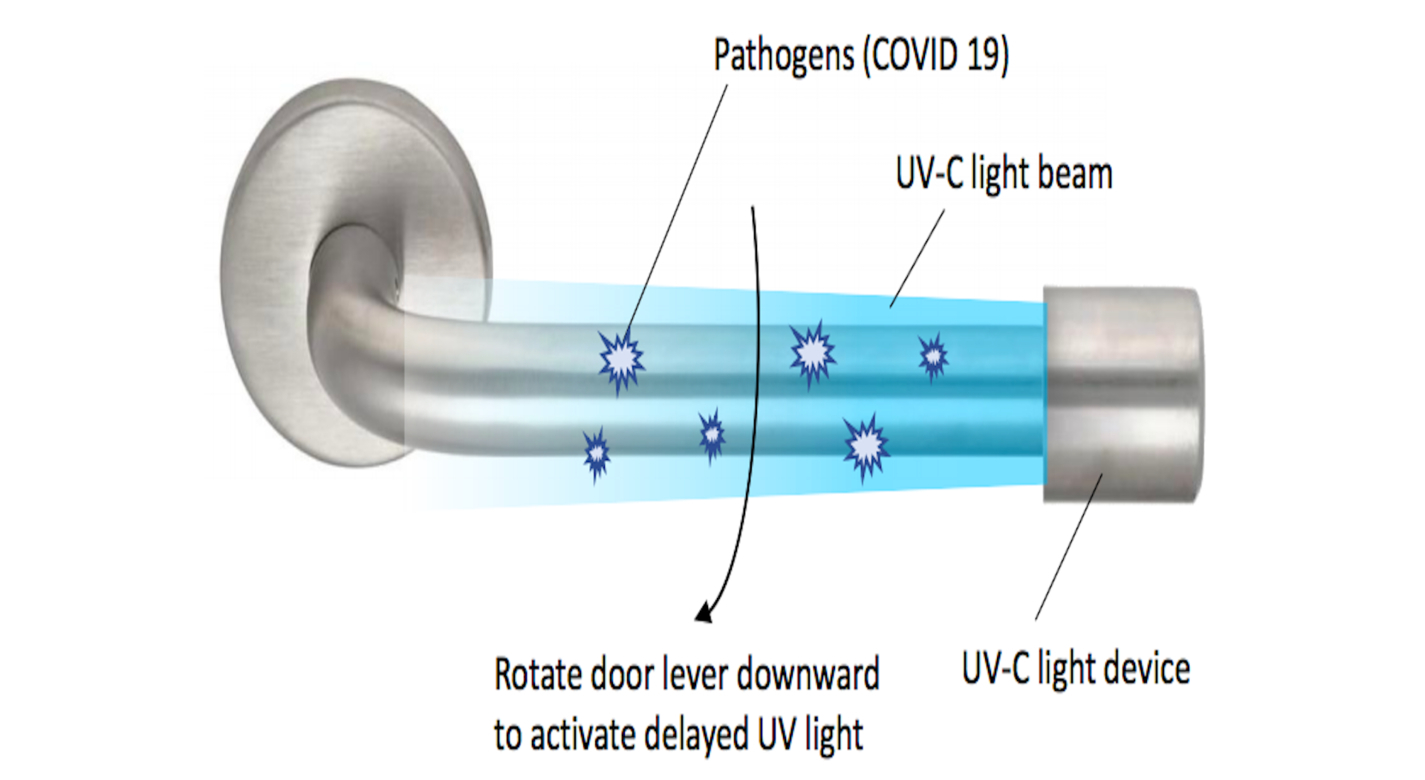Self-Cleaning Germicidal Door Handle
health medicine and biotechnology
Self-Cleaning Germicidal Door Handle (MFS-TOPS-114)
Prevent pathogen transmissions via automatic disinfection of high-touch surfaces
Overview
Surfaces such as doorknobs, levers, or handles especially those in public or high-traffic areas are known to harbor bacteria and viruses. Studies have shown that SARS-CoV-2, the virus responsible COVID-19, can survive for up to three days on plastic and stainless-steel surfaces, two materials that are commonly used to manufacture these high-touch surfaces. Thus, when contaminated, these surfaces facilitate the transmission of harmful pathogens. Ordinary cleaning agent wipes and sprays are simple methods to sanitize such surfaces; however, continuous maintenance of high-traffic areas is costly and logistically challenging. New methods are needed to rapidly disinfect such high-touch surfaces at low cost.
In response to this issue, engineers at NASA Marshall Space Flight Center developed the Ultraviolet Germicidal Door Handle. This invention is a compact and easy-to-install door lever or handle that performs automatic self-decontamination after each use.
The Technology
As previously mentioned, doorknobs, levers, and handles are commonly manufactured using plastic or stainless-steel materials. Since bacteria and viruses can survive for extended periods of time on such materials, these objects can facilitate the transmission of pathogens between users. Furthermore, it is burdensome and costly for organizations to implement cleaning protocols where door handles are cleaned continuously. To address this issue, UV sterilization systems have been used for door handles. However, such systems often require bulky mounting equipment, possess sub-optimal aesthetics, and are high price point products leaving significant room for improvement.
To overcome the limitations of using cleaning agents, sprays, or bulky high-cost sterilizing systems, NASA developed an Ultraviolet Germicidal Door Handle. This invention largely resembles a conventional doorhandle; however, it contains a compact, far UV-C LED light device that attaches to the handle via mounting threads and disinfects surfaces (i.e., kills or inactivates pathogens). The device is controlled by a sensor that activates the UV-C light for a specified time to disinfect the surface after each use. After disinfection is completed, a timer sequence switches the light off and prepares for the next use. Due to the simple, thread-based mounting system, the UV-C LED is easily removable from the door handle. The UV-C LED has several convenient features including a USB charging port, I/O switch, and low battery indicator light.
The Ultraviolet Germicidal Door Handle greatly minimizes the risk of harmful pathogens, such as SARS-CoV-2, being transmitted between people using the same door. Various versions of the Ultraviolet Germicidal Door Handle could be marketed to accommodate different designs of door handles and levers.


Benefits
- Rapid, automatic surface disinfection: The UV-C light source kills pathogens rapidly, in part due to its close proximity to the handle surface. The light source is autonomously activated after handle use, and switches off after a brief disinfection process.
- UV-C efficacy: UV-C light damages pathogen nucleic acids (DNA, RNA). As a result, pathogens are unable to replicate and are inactivated/killed. UV disinfection systems have been widely used in hospitals and biological laboratories for over 75 years.
- Functional design: The UV-C germicidal device is easily removable for quick charging or battery replacement, and does not affect the primary function of the door handle.
- Safe to use: The far UV-C LED device is safe for hands and eyes due to the carefully designed orientation of the light beam and a time-delay feature that only disinfects the handle when not in use.
Applications
- Automatic disinfection of door handles: This NASA invention enables automatic self-cleaning of door handles in public or otherwise highly trafficked buildings. Examples include industrial and commercial buildings, healthcare offices, hospitals, restaurants, and schools.
- COVID-19 disinfection protocols: NASA's self-cleaning germicidal door handle can help reduce the transmission of the SARS-CoV-2 virus, without requiring burdensome manual disinfection.
Technology Details
health medicine and biotechnology
MFS-TOPS-114
MFS-34006-1
|
Tags:
|
Similar Results

Particle Contamination Mitigation Methods
The following methods can be used individually or in combination to generate superhydrophobic surfaces:
Synthesis of novel copolyimide oxetanes with unique surface properties
The technology is the synthesis of a polyimide coating or film with a modified surface chemistry shown in Figure 1. A minor amount of an oxetane reactant containing fluorine is added to the polyimide, and the oxetane preferentially migrates to the surface, enabling relatively high concentrations of fluorine at the surface, without compromising the functional performance of the bulk of the polymide coating/film.
The copolymers exhibit mitigation of particle adhesion and fouling from exposure to various particulate and biological contaminants and exhibit reduced surface energy and increased surface fluorine content at extremely low oxetane loadings relative to the imide matrix (see Figure 2). Additionally, the short fluorinated carbon chains do not bioaccumulate, reducing the environmental impact of these materials.
Modifying surface energy via laser ablative surface patterning
This method uses a laser to create nanoscale patterns in the surface of a material to increase the hydrophobicity of the surface (see Figure 2). The benefits of hydrophobic surfaces include decreases in friction and increases in self-cleaning properties. This is an advantageous method of surface modification because it is fast and single-step, promises to be scalable, requires no chemicals, could be applied to a variety of materials, and does not require a planar surface for patterning.

Alternative Transparent Coating Lotus Suitable for Optics with Vacuum Deposition Layer
In addition to previous LOTUS coating formulations, an additional optical formulation may be applied via vacuum deposition. This coating forms a top layer and may be applied in different thicknesses that serve to enhance its hydrophobic properties. The vacuum deposited material may comprise fluorinated ethylene propylene or a similar material. This coating is transparent and can be used on optical components or any other applications requiring a clear coating.

High Flow Differential Cleaning
NASA developed this High Flow Differential Cleaning technology in response to in-house needs for a more automated and effective method to remove stubborn particles from complex parts fabricated using powder-bed-fusion equipment. The invention uses a large volume of pressurized air to quickly enter a cleaning chamber. Based on the Bernoulli principle and Continuity equation, the high flow results in significant air velocity and a decrease in pressure when airflow passes through smaller component orifices, which in turn removes remnant powder from the part. In one embodiment, the invention consists of a (1) high-pressure air compressor with ISO 8573 Class 2 drying capability, (2) a large pressure chamber with a fast-actuated valve system to, (3) a cleaning chamber containing various sensors, injection systems, (4) a test fixture designed for easy orientation adjustments, and (5) an expansion chamber allowing air to expand and drop in velocity, particles to settle, and filtered air to re-enter the room. This NASA technology can be implemented as a standalone cleaning system for powder bed fusion additively manufactured parts, or could be integrated into a packaged post-processing system offering. CT scans of complex NASA parts cleaned using a proof-of-concept system based upon the invention revealed very promising results.
NASA welcomes industry to test the cleaning speed and efficacy of the technology under an evaluation license.
Multidimensional Damage Detection System
The Damage Detection System consists of layered composite material made up of two-dimensional thin film damage detection layers separated by thicker, nondetection layers, coupled with a detection system. The damage detection layers within the composite material are thin films with a conductive grid or striped pattern. The conductive pattern can be applied on a variety of substrates using several different application methods. The number of detection layers in the composite material can be tailored depending on the level of damage detection detail needed for a particular application. When damage occurs to any detection layer, a change in the electrical properties of that layer is detected and reported. Multiple damages can be detected simultaneously, providing real-time detail on the depth and location of the damage.
The truly unique feature of the System is its flexibility. It can be designed to gather as much (or as little) information as needed for a particular application using wireless communication. Individual detection layers can be turned on or off as necessary, and algorithms can be modified to optimize performance. The damage detection system can be used to generate both diagnostic and prognostic information related to the health of layered composite structures, which will be essential if such systems are utilized to protect human life and/or critical equipment and material.

Smart Coating for Corrosion Detection and Protection
The smart coating is based on the controlled release of corrosion inhibitors and indicators from specially formulated microcapsules and particles pioneered by NASA (patent allowed). The coating detects corrosion in its early stages, inhibits it, and/or repairs the coating. The onset of corrosion triggers the release of compounds that indicate and inhibit corrosion. Mechanical damage to the coating triggers the release of film-forming compounds to repair the damage. In practice, the corrosion-responsive microcapsules detect the chemical changes that occur when corrosion begins and respond by releasing their contents. A corrosion indicator will identify the affected region with a color change, and healing agents and corrosion inhibitors help mitigate the corrosion.
The microcapsules can be tailored for incorporation into different coating systems. This multifunctional coating system will reduce maintenance cost and improve safety by preventing catastrophic corrosion failures. The coating can reduce infrastructure life cycle costs by extending the life of corrosion-susceptible structures and components, reduce inspection times of structures, and reduce the level of repair for corrosion-affected areas.



